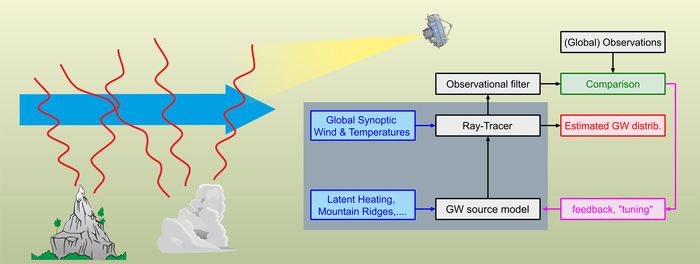Spatio-Temporal Gravity Wave Source Variability (SV)

PIs:
Peter Preusse, Forschungszentrum Jülich GmbH, Jülich
Manfred Ern, Forschungszentrum Jülich GmbH, Jülich
Ulrich Achatz, Goethe Universität Frankfurt, Frankfurt/Main
Gergely Bölöni, Goethe Universität Frankfurt, Frankfurt/Main
PhD Students/Postdocs:
Isabell Krisch, Forschungszentrum Jülich GmbH
Cornelia Strube, Forschungszentrum Jülich GmbH
Young-Ha Kim, Goethe Universität Frankfurt
Summary
The goal of this project is to understand the role of gravity wave (GW) sources in shaping the global distribution of GWs. For this we combine observations and modeling. Observations represent reality. However, in order to gain understanding we need a theory and, for quantitative understanding, a process model which formulates our concepts and which is to be tested against the observations. Therefore in SV three different sets of global distributions are compared: 1.) a combination of GW source models and GW propagation, 2.) GWs resolved by the UA-ICON GCM and 3.) remote sensing observations from various satellites. By confronting distributions from GW source models with observations we can on the one hand determine free parameters of the models and, on the other hand, assess at which altitudes, regions and seasons which sources are dominant for GW momentum flux (GWMF) and the drag exerted on the main circulation. With increasing resolution, UA-ICON (cf. GWING) resolves a larger part of the GW spectrum. Whether these distributions are realistic, is tested by comparison versus satellite observations. Sources in ICON can be identified by tracing GWs backwards to potential source processes as well as by comparison to the dedicated source models. This allows us to diagnose the reason for deviations and to develop strategies for improvement. In particular, a focus will be on the interaction of orography and spontaneous imbalance (SI): during the GW-LCycle campaign unique 3D temperature measurments were performed with the limb imager GLORIA. In several research flights we have indication of the interplay of both potential source mechanisms. All comparisons of measurements and models performed in SV will take into account the full observational filter of the observation technique. The observational filter quantifies the effect that every observation technique covers only a part of the wave spectrum and that in particular nowadays global observations underestimate the GWMF even in the resolved part of the spectrum. When performing comparisons we consider mean values of GWMF and its variation by season, region and altitude as well as the intermittency of the GWs, that is the distribution of the frequency of large and small wave events. At all resolutions of ICON we aim at a realistic representation of GWs either by resolved waves or by a parametrization which couples sources to the propagation model MS-GWaM. MS-GWaM was developed and integrated into ICON in the project 3DMSD. A particular strength of MS-GWAM is the ability to model direct transient interaction.

